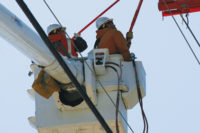PPE or ordinary clothing? Court rules on “donning and doffing” case

 The U.S. Supreme Court ruled that for legal purposes, protective items are not different from ordinary clothing, so workers at a U.S. Steel Corp. plant do not have to be compensated for the time they spend “donning and doffing” them.
The U.S. Supreme Court ruled that for legal purposes, protective items are not different from ordinary clothing, so workers at a U.S. Steel Corp. plant do not have to be compensated for the time they spend “donning and doffing” them.
In Sandifer v. United States Steel Corporation, approximately 800 employees at the company’s Gary, Indiana facility sought back pay for time spent donning and doffing pieces of protective gear that the company requires workers to wear because of hazards at its steel plants. In the aggregate, the amount of time—and thus money—involved is likely to be quite large.
At issue: whether or not flame-retardant attire, work gloves and hard hats are PPE or clothing. The Fair Labor Standards Act excludes “changing clothes” from the time for which unionized employees must be paid.
In a unanimous ruling, the justices said Monday there was no basis for petitioners’ proposition that the unmodified term “clothes” somehow omits protective clothing.
Twelve types of PPE
The petitioners wanted to be paid for the time spend donning and doffing 12 common kinds of required protective gear: a flame-retardant jacket, pants, and hood; a hard hat; a snood; wristlets; work gloves; leggings; metatarsal boots; safety glasses; earplugs; and a respirator.
Writing the opinion of the court, Justice Antonin Scalia said that the first nine items fit within the interpretation of ‘clothes,’ designed and used to cover the body and are commonly regarded as articles of dress.
Hats and boots
“That proposition is obvious with respect to the jacket, pants, hood, and gloves,” wrote Scalia. “The hardhat is simply a type of hat. The snood is basically a hood that also covers the neck and upper shoulder area; on the ski slopes, one might call it a ‘balaclava.’ The wristlets are essentially detached shirtsleeves. The leggings look much like traditional legwarmers, but with straps. And the metatarsal boots—more commonly known as ‘steel-toed’ boots—are just a special kind of shoe.”
He noted, however, that glasses, earplugs and respirators are not commonly regarded as articles of dress.
The law and trifles
“The question is whether the time devoted to the putting on and off of these items must be deducted from the noncompensable time. If so, federal judges must be assigned the task of separating the minutes spent clothes-changing and washing from the minutes devoted to other activities during the period in question. Some Courts of Appeals, including the Court of Appeals in this case, have sought to avoid, or at least mitigate, this difficulty by invoking the doctrine de minimis non curat lex (the law does not take account of trifles).”
Click here to read the Supreme Court decision.
Looking for a reprint of this article?
From high-res PDFs to custom plaques, order your copy today!





